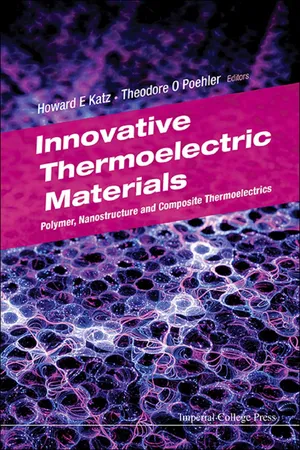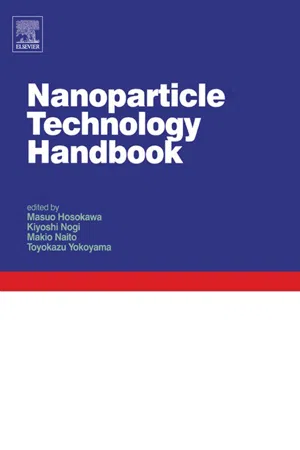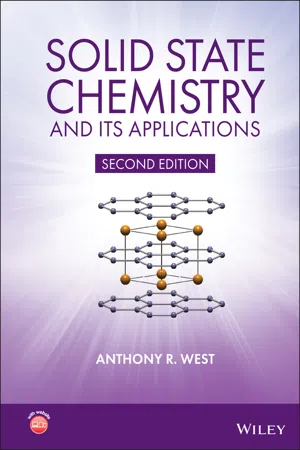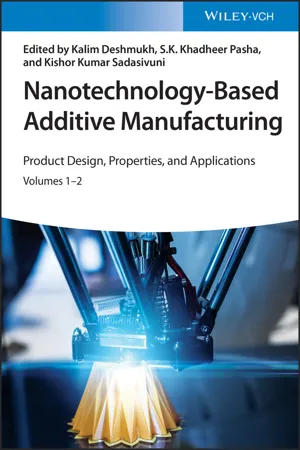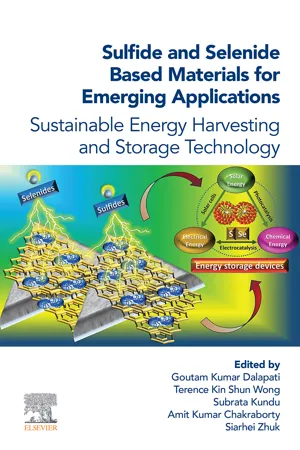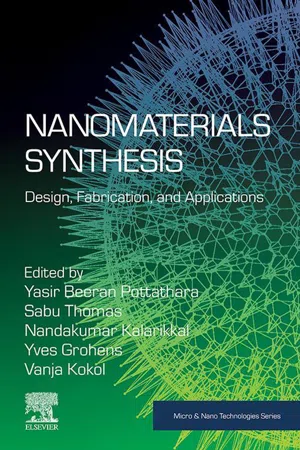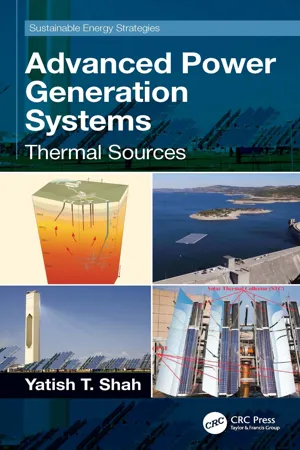Technology & Engineering
Thermoelectric Effect
The thermoelectric effect is the phenomenon where a temperature difference in a material leads to the generation of an electric voltage. This effect is utilized in thermoelectric devices, which can convert heat directly into electricity. It has applications in power generation, waste heat recovery, and cooling systems, making it a promising technology for energy efficiency and sustainability.
Written by Perlego with AI-assistance
Related key terms
Related key terms
1 of 4
Related key terms
1 of 3
10 Key excerpts on "Thermoelectric Effect"
- eBook - ePub
Innovative Thermoelectric Materials: Polymer, Nanostructure And Composite Thermoelectrics
Polymer, Nanostructure and Composite Thermoelectrics
- Howard E Katz, Theodore O Poehler(Authors)
- 2016(Publication Date)
- WSPC(Publisher)
Thermoelectric power sources have been familiar for many years, but have not been viewed as an important solution to energy problems because of their usual limited capacity and low efficiency. However, it is possible that a new vision for the application of thermoelectric power sources would be feasible if the thermoelectric technology advances in the same manner as has been occurring with improved solar energy sources.1.1.2 Fundamental characteristics of Thermoelectric Effects
The basic source of the Thermoelectric Effect is the transport of electrical charge and energy in conducting materials.4 The equilibrium flow of electric charge and thermal energy establishes a potential difference between the hot and cold ends of the material. In more specific terms, the temperature gradient induces a change in the equilibrium distribution function f (k ) that describes the distribution of electrons among various allowed energy levels for different magnitudes of the wave vector k . The change in the distribution function to a new value may cause motion of both electrical charges and heat.1.1.2.1 Electrostatic equilibriumIn an equilibrium semiconductor with no applied electric field, but with a thermal gradient, the distribution of electrons and holes among the available states is different on the hot side from that on the cold side, exclusively from the spatial variation in the Fermi distribution function for the different temperatures of the densities of states at the opposite ends. This creates a density gradient in the number of carriers in each state at the opposing regions. Therefore, carriers diffuse in response to this gradient, effectively raising the carrier temperature on the cold side also. However, the carriers on the cold side reach an elevated electrochemical potential because of the accumulating voltage from the transfer of the carriers. Electrostatic equilibrium is reached when the sum of the free energies of all the carriers, including contributions from entropy increases from populating higher energy states on the cold side and the effect of the voltage that also builds up between the hot and cold sides, reaches a minimum. This voltage may be expressed as the area charge density per specific capacitance at each position of the sample. It is assumed that this movement of charge does not actually change the phonon temperature of either side; external thermal power maintains the temperature difference independently of the movement of the carriers. - eBook - ePub
- Masuo Hosokawa, Makio Naito, Toyokazu Yokoyama, Kiyoshi Nogi(Authors)
- 2007(Publication Date)
- Elsevier Science(Publisher)
6.4.3 Thermoelectric propertiesThermoelectric conversion is a direct energy conversion between thermal and electrical energies. It is based on Seebeck effect and Peltier effect in the electrical conductors. Most of degenerated semiconductors and special metals with high carrier density used for this purpose are called “thermoelectric materials.” The energy conversion performance of the material is defined by electrical and thermal transport coefficients, more exactly, electrical conductivity σ, Seebeck coefficient S and thermal conductivity κ.Let us consider a closed circuit consisting of serial connections of p- and n-type thermoelectric materials and under an electrical load as shown in Fig. 6.4.14a . Applying forced temperature gradient T H –T L along the sample length and assuming perfect thermal insulation, the thermal to electrical energy conversion efficiency is expressed as follows [1 ].Figure 6.4.14 Schematics of thermoelectric power generation (a) and Peltier cooling (b).η =(6.4.10)=P OUTQ INT H−T LT H1 + Z− 1T ave1 + Z+T aveT L/T H(6.4.10)where T ave = (T H + T L )/2 and Z = σS 2 /κZ is called “Thermoelectric Figure of Merit (FOM)” and is an important performance measure of thermoelectric materials. It has a unit of inverse temperature (K−1 ).Since the Thermoelectric Effects are reversible phenomena, the electrical-to-thermal energy conversion has a similar configuration as shown in Fig. 6.4.14b . In this case, the thermoelectric materials work as a solid-state heat pump operated by an external electric current source. The maximum heat transfer from the low temperature to high temperature side at specific power consumption is called as “Coefficient of Performance (COP),” and can be expressed as follows [1 - eBook - ePub
- Anthony R. West(Author)
- 2022(Publication Date)
- Wiley(Publisher)
Thermopiles have numerous other applications. They are used in infrared thermometers for medical applications to measure variations in body temperature and in gas burner control systems in which the voltage that is generated by the radiant heat from the flame is used to open/close a gas inlet valve. They are used as sensors in various thermal control systems, such as climate control in cars, in consumer products – printers, copiers, mobile phones – and in clothes driers. They are used to generate or sense energy from various heat sources, not only solar, but also radioactive materials, optical sources and lasers.12.1.2 Thermoelectric power generation
The Seebeck effect may be regarded as the sum of the Thomson, temperature‐gradient effect and the Peltier, junction effect. In practice, the Seebeck effect usually involves two junctions and a temperature difference between them. The thermoelectric power relates the Seebeck and Peltier coefficients by equation (12.5) , also known as the First Kelvin Relation. There is much potential for using these Thermoelectric Effects in an energy conversion technology due to their ability to convert heat directly into electricity. They are capable of acting as solid state refrigerators or conversely, as heat pumps and the devices that are made are of simple construction with no moving parts. All that is needed to extract energy, in principle, is a difference in temperature and therefore, they are very attractive as a means to utilise waste heat such as from hot exhaust gases of car engines. There are, however, still obstacles to be overcome in achieving large‐scale utilisation of thermoelectric power sources. These include limitations of the Carnot efficiency of thermal cycles and the need for improved materials with optimised thermoelectric parameters that function over a wide temperature range.The thermoelectric coefficients of many metals are small, Table 12.1 - eBook - ePub
Nanotechnology-Based Additive Manufacturing
Product Design, Properties, and Applications
- Kalim Deshmukh, S. K. Khadheer Pasha, Kishor Kumar Sadasivuni(Authors)
- 2022(Publication Date)
- Wiley-VCH(Publisher)
TE technology provides a promising alternative by harvesting electricity and reclaiming the waste heat. The phenomena of conversion of waste heat into the usable electrical power by creating an electric potential due to a temperature difference or vice versa is referred as TE effect [38]. This TE system is highly effective and eco‐friendly because of the low‐temperature gradients which are either generated from numerous power consuming or generating systems or it is relative to the environmental temperature such as solar and geothermal energy. Fortunately, TE materials, will possibly be a green option for electricity harvesting as well as for microprocessor cooling power generation to power generation due to the pollution‐free heat to electricity conversion [39]. The devices manufactured using TE materials are operational in a cooling mode. Also, non‐movable sections and simple leg‐type structures provide massive advantages over other conventional devices, including compressors, engines, and turbines. Accordingly, a huge cooling system could be built via the vapor compression cycles for classic component replacement and reduction of toxic chlorofluorocarbons along with reducing the expense and weight of the coolers and consequently saving the energy. Numerous nanostructured TE materials, including nanotubes [40], nanowires [41], bulk materials and superlattices [42], have a tendency to achieve a wide phonon scattering at the interfaces and boundaries resulting in the low thermal conductivity and inherent flexibility. Better conversion efficiency of energy, appropriate carrier density, and greater carrier mobility are all requirements for TE materials [ 43 – 45 ] - eBook - ePub
- Marc Belleville, Cyril Condemine, Marc Belleville, Cyril Condemine(Authors)
- 2012(Publication Date)
- Wiley-ISTE(Publisher)
Chapter 6Thermal Energy Harvesting 1
6.1. General presentation
The emergence of ultra-low consumption communication devices allows us to explore new solutions, such as wireless sensor networks. As the size and price of these wireless sensors keep decreasing, we can imagine that they will soon be widely used in construction, automobile manufacture, and industry. The most appropriate way to supply such sensor platforms is to harvest energy from the environment to transfer it to the sensors, making them autonomous. Conversion from thermal energy represents an interesting solution, as this energy source is almost unlimited and thermoelectric converters are reliable and easily integrated systems.First, thermoelectric conversion principles will be described. Second, the state-of-the-art of the various thermoelectric materials will be detailed, along with their associated technologies. Finally, the implementation constraints will be explained in order to discuss the opportunities to use such devices to supply autonomous electrical systems.6.2. Energy harvesting by Thermoelectric Effect
The two main Thermoelectric Effects for a given conductive or semiconductive material are the Seebeck and Peltier effects. The Seebeck effect allows us to convert thermal energy into electrical energy and the Peltier effect electrical energy into heat flow. Within this study on energy-autonomous systems, we will exclusively consider electrical energy generation through the Seebeck effect.6.2.1. Physical principle of the Seebeck effect
The Seebeck effect consists of creating an electrical potential difference at the extremities of a conductor or semiconductor when the latter is subjected to a temperature gradient. The charge carriers (electrons or holes) then are scattered from the hot point to the cold point, thereby generating an internal electrical field E (V/m) that opposes this scattering. A material’s Thermoelectric Effect is characterized by its Seebeck coefficient S (V/K), which quantifies the voltage generated for a 1°C temperature gradient ΔT - Poh Choon Ooi, Mengying Xie, Chang Fu Dee, Poh Choon Ooi, Mengying Xie, Chang Fu Dee(Authors)
- 2022(Publication Date)
- Wiley-VCH(Publisher)
Organic thermoelectric materials, especially conductive polymers, have been proposed as a promising alternative, particularly for low‐temperature (<100 °C) energy‐harvesting applications. Organic TE materials are nontoxic, flexible as they can be printed on thin foils, easy to manufacture, scalable to large areas, and potentially available at low cost [25]. In this chapter, we will discuss various aspects of the TEGs with a specific focus on organic TE materials and organic TEGs as power generation devices. 6.2 Thermoelectric Effect and Properties The Thermoelectric Effect results from three different phenomena: the Seebeck effect, Peltier effect, and Thomson effect; each of these phenomena are described in Sections (6.2.1 – 6.2.3). 6.2.1 Seebeck Effect Seebeck effect is described as the phenomenon that results in an induced voltage across an electrical conductor or semiconductor when a temperature difference is applied between its two ends (Figure 6.3)- eBook - ePub
Sulfide and Selenide Based Materials for Emerging Applications
Sustainable Energy Harvesting and Storage Technology
- Goutam Kumar Dalapati, Terence Kin Shun Wong, Subrata Kundu, Amit Kumar Chakraborty, Siarhei Zhuk(Authors)
- 2022(Publication Date)
- Elsevier(Publisher)
[18–23] .The counterpart of this is the Peltier effect used in Peltier coolers. A current is applied across the thermoelectric material and the Peltier effect drives the charge carriers to the corresponding polarizations. The movement of charges away from one end will produce a cooling effect while the other end will be heated. Thermoelectric modules consist of many p-type and n-type materials arranged electrically in series, and thermally in parallel. For TEGs, the presence of a temperature slope ΔT between the two ends causes a diffusion of charge carriers in the TE material from the hotter side, Th , toward the cooler side, Tc . An electromotive force is developed across the material as described in Eq. (12.1) whereby S (expressed in volts per kelvin) corresponds to the Seebeck coefficient and is positive for p-type and negative for n-type [24] .E sbe= S . Δ T(12.1)Fig. 12.2 depicts the Seebeck effect in a schematic of a TEG and the aforementioned flow of charges according to the temperature gradient and the corresponding direction of the induced current [25 , 26 ]. The effectiveness of a thermoelectric material can be evaluated by its dimensionless figure-of-merit, ZT as defined by Eq. (12.2) which is determined by the Seebeck coefficient (S), electrical conductivity (σ), and thermal conductivity (κt ) at various temperatures [4 , 26 , 27] . Subsequently, combination of the variables S2 σ is termed power factor (PF) and thermal conductivity can be further separated into its various lattice (κL ) and electrical (κe - eBook - ePub
Energy Harvesting and Storage Devices
Sustainable Materials and Methods
- Laxman Raju Thoutam, J. Ajayan, D. Nirmal, Laxman Raju Thoutam, J. Ajayan, D. Nirmal(Authors)
- 2023(Publication Date)
- CRC Press(Publisher)
4 Constructive Approach Towards Design of High-Performance Thermoelectrics, Thermal Diodes, and Thermomagnetic Devices for Energy Generation Applications Saurabh Singh, Bed Poudel, Amin Nozariasbmarz, Tsunehiro Takeuchi, and Shashank PriyaDOI: 10.1201/9781003340539-44.1 Introduction
Electrical energy plays a vital role in driving daily life activities in our society. Fossil fuel-based electricity consumption has resulted in an increased environmental impact driving climate change [1 –6 ]. Alternative energy harvesting approaches are needed that can provide electricity generation without any harmful impact on the environment. Typically, in an energy conversion process, 40–60% of energy is wasted in the form of heat. Thus, heat represents a major source of wasted energy that can be converted into electricity. One of the promising methods for heat to electricity conversion is based on the Thermoelectric Effect, which will be discussed at the beginning of this chapter [7 –12 ]. Thermoelectric electricity generation requires no moving component, and it can be designed using earth-abundant materials. Waste heat in the environment is available in a wide temperature ranging from near room temperature to a few hundred degrees Celsius. Based on the temperature range, heat content, and intended thermal management outcomes, approaches based on thermoelectricity, thermal diodes, thermal rectifiers, and thermomagnetic can be utilized. The details of each of these mechanisms are presented in the subsequent sections.4.2 Energy Harvesting Using Thermoelectricity
The schematic of the Thermoelectric Effect is demonstrated in Figure 4.1 . It consists of a thermoelectric generator (TEG) that comprises a thermoelectric module made from several n- and p-type thermoelectric materials (discussed later); and an electric load (light bulb) in series to the TEG. An electric voltage (ΔV) is generated from the TEG when temperature gradient ΔT - eBook - ePub
Nanomaterials Synthesis
Design, Fabrication and Applications
- Yasir Beeran Pottathara, Sabu Thomas, Nandakumar Kalarikkal, Yves Grohens, Vanja Kokol, Yasir Beeran Pottathara, Sabu Thomas, Nandakumar Kalarikkal, Yves Grohens, Vanja Kokol(Authors)
- 2019(Publication Date)
- Elsevier(Publisher)
Regarding the Seebeck effect, when the junctions at the top are heated and those at the bottom are cooled, a temperature difference will occur. The electron/hole pairs are created at the hot end by absorbing heat, then they recombine and liberate heat at the cold end. Driven by the mobility of the hole/electron, the Seebeck voltage generates between the two ends, resulting in a current flow. As for the process of TE cooling or the “Peltier effect,” when a voltage is applied across a p/n junction, electron/hole pairs are generated in the vicinity of the junction and flow away, leading to cooling of the junction on one end and heating on the other end. Figure 9.7 Operation principle of (A) a TEG and (B) a Peltier device. A TE device generally consists of p - and n -type TE materials connected in series through conducting plates. For an ideal TE device with constant TE properties, the maximum heat to electrical power conversion efficiency (η max) and the output power density (P max) are expressed as: n max = T H − T C T H · 1 + ZT ¯ − 1 1 + ZT ¯ + T c T h (9.7) (9.7) P max = (T H − T C) 2 4 L · S 2 σ ¯ (9.8) (9.8) where L is the length of the TE leg, and T C and T H are the. cold-side and hot-side temperatures, respectively. The cooling efficiency of a TE cooling device is characterized by the coefficient of performance (COP). COP = T C T H − T C 1 + ZT ¯ − T H T C 1 + ZT ¯ + 1 (9.9) (9.9) The term ZT ¯ [otherwise reported as ZT M with T M the average temperature, T M =(T H + T C)/2] is the average value of ZT, the TE device figure of merit, between the hot and cold sides and is defined by Eq. (9.10). ZT = S 2 RK · T (9.10) (9.10) where S, R, K, T are Seebeck coefficient, electrical resistance, thermal conductance, and absolute temperature, respectively. Another expression of COP is the following, described by Eq - eBook - ePub
Advanced Power Generation Systems
Thermal Sources
- Yatish T. Shah(Author)
- 2022(Publication Date)
- CRC Press(Publisher)
152 ].There are several ways to calculate the performance of a thermoelectric couple in terms of energy production, either averaging or using finite elements [153 ,154 ]. The averaging methods overestimate the efficiency but provide an immediate value based on the calculated properties of the TEG at the average junction temperature [155 ]. On the other hand, finite elements require a lot of iterations and therefore take more time to obtain results [156 ]. Although simple one-dimensional analytical models are frequently used to predict the performance of such devices [157 ], the diversity and complexity of thermoelectric applications generally require a complete three-dimensional (3D) numerical analysis [158 ], using simulation tools such as ANSYS [159 ], GT-SUITE [160 ], FLUENT [161 ] and GTPower [162 ]. Simple relationships among TE efficiency, temperature, ZT and Carnot efficiency are illustrated in the following Figure 8.11 .FIGURE 8.11 Relationships among TE efficiency, temperature, ZT and Carnot efficiency [163 ].8.4.2 Thermoelectric Module
The promotion of TE generators required the manufacturing of TE modules that can be used by broader market at different scales. In 1959, the General Electric company commercialized [164 ] thermoelectric modules composed of 36 couples of bismuth telluride in flat bulk architecture. Nowadays, Champier [165 ] has shown that numerous companies all over the world manufacture TE modules. A typical thermoelectric generator (TEG) module consists of between 10 and 100 thermoelectric elements of type n and type p, electrically connected in series and thermally in parallel, and interposed between two ceramic layers, as shown in Figure 8.12 . The p–n pairs are joined by conductive tabs connected to the elements via a low melting point solder (PbSn or BiSn). When a temperature gradient occurs between its two junctions, the TEG converts thermal energy into electrical energy according to the principle of the Seebeck effect. This flat bulk architecture is the most widely used and marketed. However, in some applications adapting heat source to thermoelectric device requires a shape different from a flat plate. While different shapes can make the device more costly, heavy and cumbersome, a flat shape is not always practical because of the difficulty in adapting the heat source to the thermoelectric device. As a result, other designs such as cylindrical shape [166 ,167 ,168 ], thick and thin films and flexible TE devices [169
Index pages curate the most relevant extracts from our library of academic textbooks. They’ve been created using an in-house natural language model (NLM), each adding context and meaning to key research topics.
Explore more topic indexes
Explore more topic indexes
1 of 6
Explore more topic indexes
1 of 4
